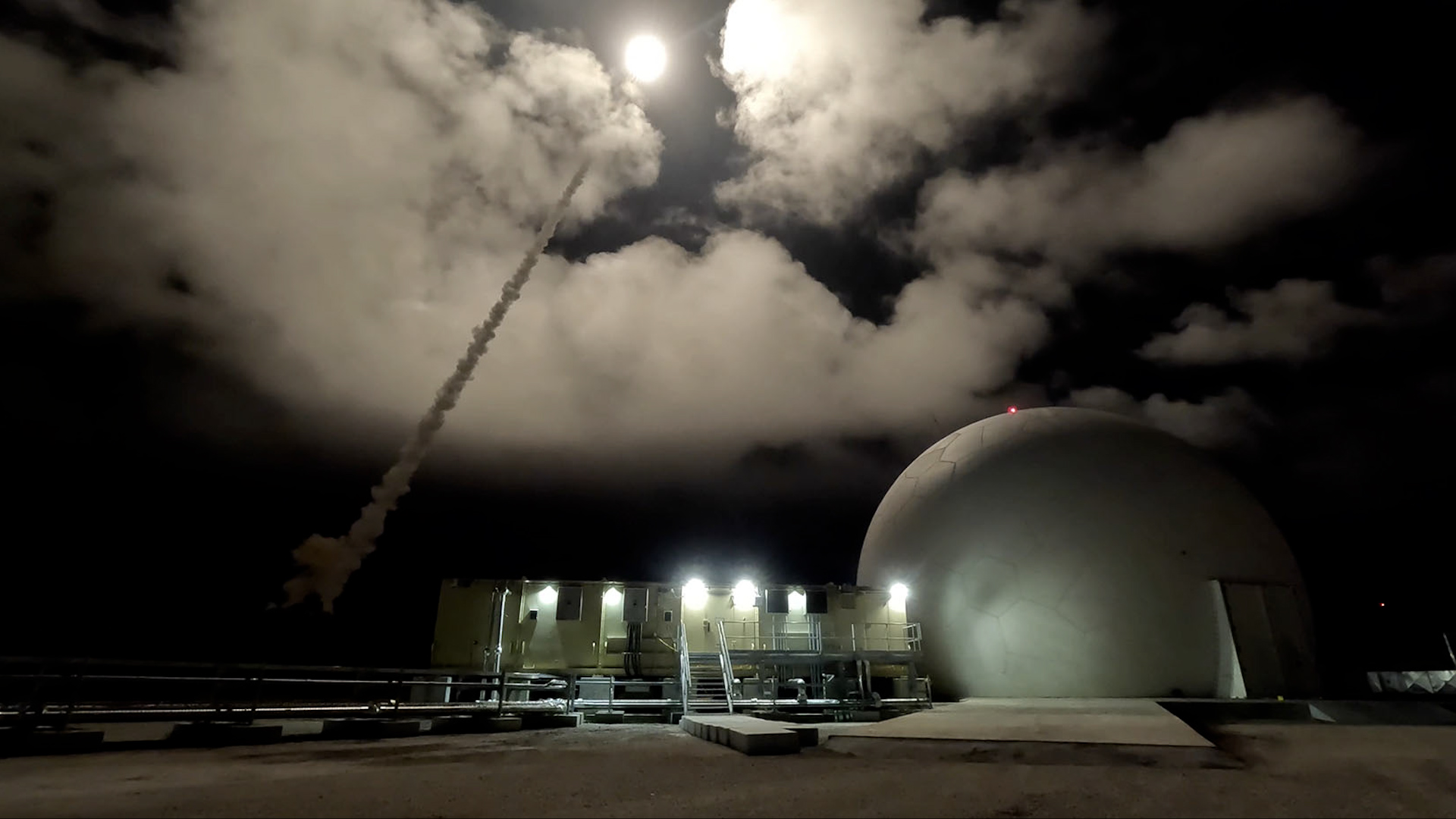
Ballistic missile intercepted over Guam during landmark defense test
By Ryan Robertson (Anchor), William Jackson (Producer), Kaleb Gillespie (Video Editor)
In the event of a conflict between the United States and China, U.S. bases in the Pacific, including Guam, would play a critical role. Known as the “hub of the Pacific,” Guam is essential to U.S. military strategy in eastern Asia and the South China Sea.
Media Landscape
See how news outlets across the political spectrum are covering this story. Learn moreBias Distribution
Left
Right
Untracked Bias
A recent test to intercept a ballistic missile aimed at Guam demonstrated advancements in missile defense technology. The Missile Defense Agency reported that the test was successful, marking a key step in developing a layered defense system for the island.

Download the SAN app today to stay up-to-date with Unbiased. Straight Facts™.
Point phone camera here
Intercepting ballistic missiles is a significant challenge due to their hypersonic speeds and high-altitude trajectories. However, recent advancements in missile defense, seen in conflict zones like Ukraine and the Middle East, are shaping Guam’s new defense infrastructure. The system integrates advanced radars, interceptors and command systems to address evolving threats.
A land-based version of the Aegis Ballistic Missile Defense System, traditionally used on naval warships, forms the core of this system. The system, paired with advanced radar technology from Lockheed Martin and additional space-based sensors, can detect threats shortly after launch and determine the most effective interception strategy.
Guam’s strategic location in the Pacific makes it vital to U.S. operations. Its bases support bombers, submarines and advanced communication systems, which are critical to projecting power in the region. Strengthening Guam’s defenses is part of the Pentagon’s broader plan to deter Chinese aggression, and ensure conflicts remain far from U.S. shores.
The planned upgrades include THAAD (Terminal High Altitude Area Defense) and Patriot systems, designed to intercept a range of missile types. Experts acknowledge that these systems may not stop every missile in a large-scale attack but aim to disrupt adversary planning and reduce potential damage.
Residents of the island have raised concerns about the impact of increased military activity on local resources, including housing and infrastructure. Some worry that enhanced defenses could make the island a more prominent target, while others emphasize the importance of ensuring Guam’s safety through military preparedness.
Get up to speed on the stories leading the day every weekday morning. Sign up for the newsletter today!
Learn more about our emails. Unsubscribe anytime.
By entering your email, you agree to the Terms & Conditions and acknowledge the Privacy Policy.
The U.S. plans to begin constructing critical defense sites in 2025 and will conduct further tests to refine the system’s capabilities. Defense officials say these efforts are a necessary step in securing the island and maintaining stability in the Indo-Pacific region.
[Ryan Robertson]
IN THE EVENT OF A WAR BETWEEN THE U-S AND CHINA, US BASES IN THE PACIFIC WILL PLAY A VITAL ROLE. LIKE GUAM–KNOWN AS THE HUB OF THE PACIFIC.
WHICH IS WHY A RECENT TEST TO INTERCEPT A BALLISTIC MISSILE AIMED AT THE ISLAND IS SO IMPORTANT.
OH, THE MISSILE DEFENSE AGENCY SAYS THE TEST WENT GREAT BY THE WAY.
SWATTING DOWN BALLISTIC MISSILES IS NOTORIOUSLY DIFFICULT. THEY MOVE AT HYPERSONIC SPEEDS AND AT ALTITUDE…BUT DOWNING THEM ISN’T IMPOSSIBLE ADVANCES IN MISSILE DEFENSE TECHNOLOGY, SHOWCASED RECENTLY IN UKRAINE AND THE MIDDLE EAST, ARE SHAPING GUAM’S NEW DEFENSE SYSTEM, WHICH AIMS TO BUILD A LAYERED NETWORK OF ADVANCED RADARS, INTERCEPTORS, AND COMMAND SYSTEMS.
AT THE CORE OF THE SYSTEM IS A LAND-BASED VERSION OF THE AEGIS BALLISTIC MISSILE DEFENSE SYSTEM USED ON NAVAL WARSHIPS. PAIRED WITH AN ADVANCED RADAR FROM LOCKHEED MARTIN AND OTHER SPACE-BASED SENSORS — AEGIS DETECTS THREATS ALMOST AS SOON AS THEY GO AIRBORNE AND THEN DECIDES ON AND DEPLOYS THE THE MOST EFFECTIVE INTERCEPTION STRATEGY.
GUAM’S LOCATION IN THE WESTERN PACIFIC MAKES IT VITAL TO U.S. MILITARY OPERATIONS IN EAST ASIA AND THE SOUTH CHINA SEA. ITS BASES SUPPORT BOMBERS, SUBMARINES, AND ADVANCED COMMUNICATION SYSTEMS. STRENGTHENING ITS DEFENSES IS PART OF THE PENTAGON’S BROADER PLAN TO DETER CHINESE AGGRESSION IN THE REGION…AND KEEP THE FIGHTING….OVER THERE.
THE DEFENSE UPGRADES INCLUDE THAAD AND PATRIOT SYSTEMS DESIGNED TO INTERCEPT A RANGE OF MISSILE TYPES. HOWEVER, AND THIS IS AN IMPORTANT POINT–EXPERTS ACKNOWLEDGE WHILE THE SYSTEM MAY NOT STOP EVERY MISSILE IN A LARGE-SCALE ATTACK, IT AIMS TO DISRUPT ADVERSARY PLANNING AND LIMIT DAMAGE.
SOME GUAM RESIDENTS ARE EXPRESSING CONCERNS ABOUT THE STRAIN THAT INCREASED MILITARY ACTIVITY COULD PLACE ON LOCAL RESOURCES, INCLUDING HOUSING AND INFRASTRUCTURE. THERE ARE ALSO WORRIES BOLSTERING DEFENSES MIGHT MAKE THE ISLAND A MORE PROMINENT TARGET. OTHERS HIGHLIGHT THE IMPORTANCE OF MILITARY PREPAREDNESS TO ENSURE GUAM’S SAFETY.
CONSTRUCTION ON CRITICAL DEFENSE SITES IS SET TO BEGIN IN 2025, WITH ADDITIONAL TESTS PLANNED TO FURTHER DEVELOP THE SYSTEM’S CAPABILITIES.
FOR MORE OF OUR UNBIASED, STRAIGHT FACT REPORTING – DOWNLOAD THE STRAIGHT ARROW NEWS APP TODAY, OR LOG ON TO SAN.COM.
Media Landscape
See how news outlets across the political spectrum are covering this story. Learn moreBias Distribution
Left
Right
Untracked Bias
Straight to your inbox.
By entering your email, you agree to the Terms & Conditions and acknowledge the Privacy Policy.
MOST POPULAR
-
 Getty Images
Getty Images
Democrats in Congress receive lowest approval rating in Quinnipiac poll history
Watch 2:5911 hrs ago -
 Getty Images
Getty Images
AG Bondi reviewing Epstein documents for release, could hold client list
Watch 1:4811 hrs ago -
 Getty Images
Getty Images
Speaker Johnson won’t support DOGE stimulus checks
Watch 2:0613 hrs ago -
 Reuters
Reuters
UN chief reveals his plan for peace in Haiti to Caribbean leaders
Watch 2:1515 hrs ago




